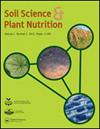Radioactive Cs transfer to vegetables after the FDNPP accident
IF 1.8
4区 农林科学
Q3 ENVIRONMENTAL SCIENCES
引用次数: 2
Abstract
ABSTRACT To evaluate the effectiveness of potassium (K) application in mitigating137Cs transfer from soil to plants, several vegetable species were cultivated under field and pot experiments. In the field experiment, squash, sweet potato, turnip, potato, and carrot were examined in 2020 and 2021 in two different areas of Hamadori (coastal region in Fukushima Prefecture). Transfer factor (TF) was calculated by dividing harvest radioactivity (Bq kg−1 dry or fresh) to soil radioactivity (Bq kg−1 dry) and was negatively correlated with the amount of exchangeable K (ExK) at harvest, regardless of the species, year, and location. In the pot experiment, edamame (immature soybean seed), spinach, turnip, and komatsuna were cultivated, and it was confirmed that ExK was the most powerful factor in regulating TF. Based on the relationship between ExK and TF for each vegetable species, the amount of ExK required to keep the 137Cs concentration lower than a certain level (standard limitation value and one-quarter of that value) was calculated.福岛核电站事故后放射性铯转移到蔬菜中
摘要为评价钾(K)对土壤中碳- 137cs向植物转移的减缓效果,采用大田和盆栽试验研究了几种蔬菜。在田间试验中,于2020年和2021年在Hamadori(福岛县沿海地区)的两个不同地区对南瓜、甘薯、萝卜、土豆和胡萝卜进行了研究。转移因子(TF)是通过将收获放射性(Bq kg−1干燥或新鲜)除以土壤放射性(Bq kg−1干燥)来计算的,与收获时的交换K (ExK)量负相关,与物种、年份和地点无关。盆栽试验中,以毛豆(未成熟大豆种子)、菠菜、芜菁和小松为对照,证实了ExK是调节TF最有力的因子。根据每种蔬菜的ExK与TF之间的关系,计算出将137Cs浓度保持在一定水平(标准限量值及其四分之一)以下所需的ExK量。
本文章由计算机程序翻译,如有差异,请以英文原文为准。
求助全文
约1分钟内获得全文
求助全文
来源期刊

Soil Science and Plant Nutrition
农林科学-农艺学
CiteScore
4.80
自引率
15.00%
发文量
56
审稿时长
18-36 weeks
期刊介绍:
Soil Science and Plant Nutrition is the official English journal of the Japanese Society of Soil Science and Plant Nutrition (JSSSPN), and publishes original research and reviews in soil physics, chemistry and mineralogy; soil biology; plant nutrition; soil genesis, classification and survey; soil fertility; fertilizers and soil amendments; environment; socio cultural soil science. The Journal publishes full length papers, short papers, and reviews.
 求助内容:
求助内容: 应助结果提醒方式:
应助结果提醒方式:


